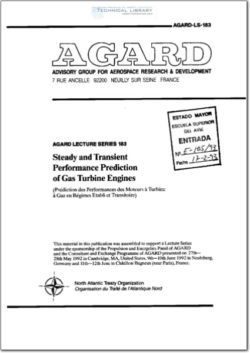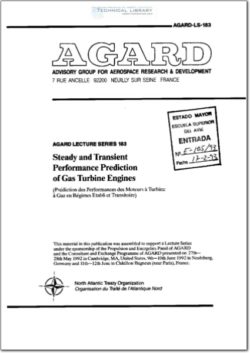AGARD-LS-183

- Version
- 302 Downloads
- 8.37 MB File Size
- 1 File Count
- April 26, 2016 Create Date
- April 26, 2016 Last Updated
Steady and Transient Performance Prediction of Gas Turbine Engines

The evaluation of engine performance obviously requires a large computing effort and mathematical models are now
an integral part of the design phase. It is obvious that engine manufacturers must be deeply involved in mathematical
modelling. but it should also be realized that M may also have a significant interest in the use of mathematical
models for investigation of in-service problems; these might include handling problems in particular flight regimes
or the application of diagnostics in Engine Health Monitoring (El-1M).
Computer modelling will be used throughout an engine development program, but there are many certification tests
which must be demonstrated on actual engines, e.g. bird strike, blade-off testing and water ingestion, and the
development period of engines has not changed significantly following the widespread use of computing.
One of the first requirements for an engine program is to predict the performance of the engine over the full range
of conditions from take-off to a variety of flight regimes such as low altitude penetration, high altitude cruise and
combat manouevring with maximum afterbuming. This requires sophisticated modelling which can be done with
a high level of confidence before the engine has run; both design point and off-design performance must be
accurately predicted. This must be done before any component testing has been carried out and the component
characteristics must be estimated and then updated as the program unfolds. In a later lecture, the topic of component
peforrnance changes between test rigs and actual engine operation will be discussed.
As the need for ever improving aircraft performance drives the engine designer to continually improve engine
performance, engines are steadily becoming more complex. Variable stator compressors, for many years found only
on GE engines, are now used on virtually all high performance engines to cope 'with steadily rising pressure ratios.
Blow-off valves are frequently used on starting or when operating at low power. Variable final nozzles are becoming
more sophisticated, with the first fully variable convergent-divergent nozzle introduced on the Olympus 593 in
Concorde; the use of variable nozzle area to optimize Concorde engine performance is well described in (2); variable
geometry turbines have not yet been introduced in aeroengines, but have been used for some years in industrial
engines for performance improvement at part load. Future military, and probably civil, engines will introduce
variable cycle technology. As an example, a future supersonic transport engine will need to operate at high by-pass
ratio and low jet velocity at take-off, to minimize noise, while operating with a very low by-pass ratio and high jet
velocity for efficient supersonic cruise.
| File | Action |
|---|---|
| AGARD-LS-183 Steady and Transient Performance Prediction of Gas Turbine Engines.pdf | Download |
Comment On This Post